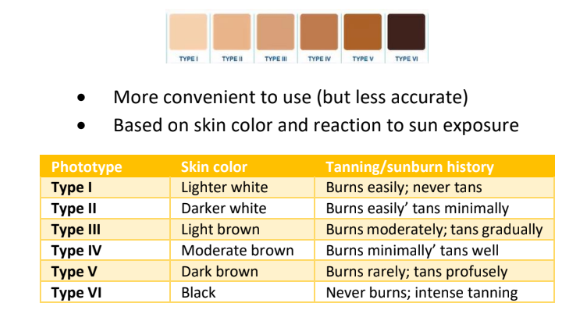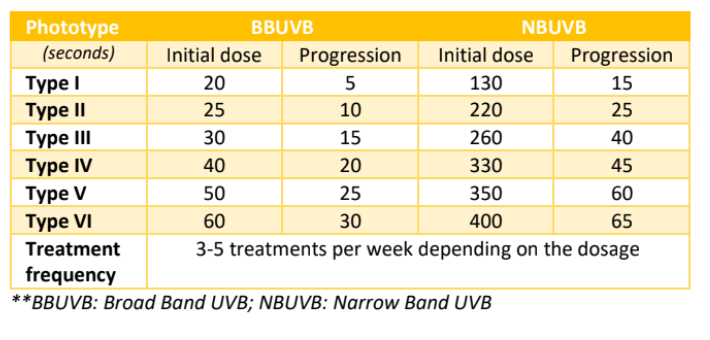Ultraviolet Radiation
1/65
There's no tags or description
Looks like no tags are added yet.
Name | Mastery | Learn | Test | Matching | Spaced |
|---|
No study sessions yet.
66 Terms
UVR has a frequency of ______________
1.65x10^15 to 7.5x10^ 14Hz
True/False: UVA is farther from visible light while UVC is closer to visble light
False
UVA is AKA
Long-wave UV; Near UV
UVB is AKA
middle-wave UC
UVC is AKA
Short-wave UV; Far UV
UVA wavelength
(315) 320-400 nm
UVB Wavelength
(280) 290 - 320
Use of UVA
Blacklight *most intense heating effect
UVB use
Skin erythema; sunburn
UVC use
Germicidal; Bactericidal
Least harmful UV; can be easily reflected back
UVC
True/False: UVR is also a thermal agent
False; UVR has photochemical effect on tissues
UVR is absorbed within the __________ of human skin
first 1-2 mm (0.22mm)
80-90% of UVR is absorbed in the?
dermis
True/False: UVR has ionizing effects
True
Excessive natural UVR exposure can cause __________
Cutaneous malignant melanoma
Basal-cell carcinoma
Squamous-cell carcinoma
Factors Affecting UV penetration
Intensity of radiation
Wavelength of radiation
Power of radiation source
Exposure duration
Distance of radiation source
Frequency
size of area
Thickness of Skin
Pigmentation of Skin
Which factors directly affects UV depth of penetration (higher = deeper penetration
Intensity
Wavelength
Power of radiation source
Exposure duration
Closer Distance
Light skin
Which factors are indirectly proportionate to UV depth of penetration
Farther distance = superficial penetration
Frequency
Size of area
Thickness of Skin
Darker complexion
(Equipment)
Burner (argon gas and mercury)
↑ pressure and temperature
(+) erythema and pigmentation
Applied >15” from the area (farther from pt)
No need for warm-up
Hot Quartz
Quartz tube with mercury (ionized vapor)
↓ pressure and temperature
Minimal erythema and (-) pigmentation
Application at close proximity
Needs 5 min warm-up
Cold Quartz
Mercury Arc Lamps vs Fluorescent Lamps
Mercury Arc Lamps | Fluorescent Lamps |
Small | Long |
Emit radiation at constant intensity | Emit higher-intensity radiation |
Used for smaller areas | Used for larger areas |
Used more in clinics | Low pressure mercury discharge tubes with phosphor coating inside |
Hot / Cold Quartz |
Dilation of blood vessels due to ______ release
histamine
Skin erythema occurs after exposure to _____ or _____ after drug sensitization
UVB or UVA
Skid redness is due to _______ release
prostaglandin release
Delayed pigmentation of the skin
Tanning
In tanning, there is increase production and upward migration of _____________ and oxidation of __________
Increased production and upward migration of melanin granules and oxidation of premelanin
How does tanning affect UV penetration
decreased penetration
Thickening of superficial layer of skin (epidermis; stratum corneum)
Epidermal Hyperplasia
Thickening of the epidermis is due to __________
cell proliferation
Epidermal Hyperplasia occurs usually after _________ of exposure to UVR
after 72 hours
Purpose of UVR for vitamin D
Converts ingested provitamin D to active vitamin D
Practical Application for the Vitamin D benefits of UVR
indicated for Psoriasis
Desquamation
sloughing off dead skin cells
UVR vs IRR
UVR | IRR |
Chemical Effect (non-thermal) | Physical effect (thermal) |
No head | Absorbed as heat |
Absorbed at 1-2 mm | Absorbed at 3mm |
Luminous sources | Luminous and non-luminous |
Delayed erythema (dark) | Immediate erythema (light) |
Erythema lasts for several days | Erythema lasts for 20-30 minutes |
Irradiance is AKA
Intensity or power density
Irradiance is measured by?
UV sensor on device
Unit of Irradiance
mW/cm²
Amount of energy delivered to skin for a single treatment
Dose per treatment; D mJ/cm² = I x T
Summation of all doses
Cumulative Dose (J/cm²)
Fitzpatrick Skin Phototype method

Recommended UV dosing based on skin phototype

Dose of UV radiation that will produce a barely detectable erythema about 8-24 hours after exposure
Minimal erythemal dose method
Degrees of Erythema
Dosage | Latent Period | Appearance | Duration |
SED | No erythema | ||
MED | 6-12 hrs | Mild pink | <24 hrs |
E1 | 6 hours | Definite pink; blanching | 2 days |
E2 | 3 hrs | very red; not blanching | 3-5 days |
E3 | <2 hrs | ‘angry’ red | 7 days |
Degrees of Erythema Effects
Dosage | Edema | Discomfort | Desquamation | Dose Multiplier |
SED | no erythema | |||
MED | x | x | x | 1 |
E1 | x | slight soreness | Powdery | 2.5 |
E2 | some | hot & painful | Thin sheets | 5 |
E3 | Blister | Very painful | Thick Sheets | 10 |
Summary of Dosimetry (Dose, Frequency, BSA)
Dosage | Dose | Progression | Frequency | BSA |
SED | 12.5% | Daily | 100% | |
MED | 1 | 25% | Daily; every other day | 50-100% |
E1 | 2.5 | 50% | Every other day | <20% |
E2 | 5 | 75% | 2x/week | 4% |
E3 | 10 | NA | 1x/week | <25 cm² |
Computation for intensity progression

For Cold Quartz (Kromayer lamp), the lamp is applied at least ______ away from the wound
1 inch
For Hot quartz lamp, the lamp is initially applied at ______ distance
60-80 cm
Distance is altered when _____________
duration has reached the maximum of 5 minutes
Narrow-band UVB is indicated for ?
Subacute and chronic psoriasis, vitiligo
MED or E1
Guidelines for application for Cystic Acne / Acne Vulgaris
E1 for face, neck and chest
E2 for back and shoulders
UVR produces desquamation effect to stimulate growth of new healthy skin and provides antibiotic effects to destroy the infecting organisms
PUVA (Psoralen + UVA) is used for:
Eczema
Urticaria
Cutaneous T-Cell Lymphoma
Some photosensitive disorders
What type of UV is used for non-infected open wounds
UVC
Wound presents with meaty red color (good sign) = _______ tissue
granulation
Dose for infected wound with thin yellowish slough
E2 daily and unprogressed
Dose for decubitus ulcers affecting the epidermis/dermis
E1/E2
Dose for infected open wounds with black slough
E3 daily
Dose for infected wounds with definite green or yellow slough
E3 daily and unprogressed
Contraindications for UVR
Over the eyes
Skin cancer
Pulmonary Tuberculosis
Cardiac, kidney, or liver disease
Systemic Lupus erythematosus
Fever
Taking birth control pills
Precautions for UVR
Photosensitivity or Photoallergy
Photosensitizing medications
Recent x-ray therapy
No dose of UV be done until the effects of the previous treatment have disappeared
Adverse Effects of UVR
Burning
Premature aging of skin
Carcinogenesis
Eye damage
UV overdose is counteracted by?
applying IRR for 20 mins every hour for 6-8 hours
Documentation for Overdose
date
lamp used
distance
exact area treated
time
reaction obtained
Common areas for MED testing
areas that are not usually exposed to the sun
volar aspect of forearm, inner thigh
Steps in Determining Dosage
Determine the MED
Determine the dosage
For initial treatment; the computed dose will be used for the initial session
Progress as necessary
compute for the progressions; max of 5 mins